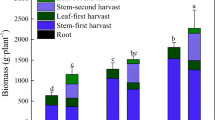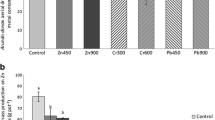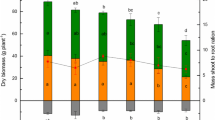Abstract
Using king grass (Pennisetum purpureum Schumach. × Pennisetum glaucum (L.) R.Br.) for phytoextraction is a promising technology for producing large amounts of biomass fuel while remediating contaminated soil. To assess the practical phytoextraction capacity of king grass, we conducted a field experiment with three different soil types (loam, sandy loam, clay loam) and cadmium (Cd) concentrations (0, 0.25, 0.5, 1, 2, 4, 8, and 16 mg kg−1, aged stably for 6 years). King grass were harvested at two different periods (elongation and maturity) to identify the optimal harvest time for extraction efficiency. The results showed that all treatments had bioconcentration factor (BCF) > 1 and translocation factor (TF) < 1; Cd is mainly stored in the roots. However, due to a high shoot biomass, the highest quantity of Cd extracted from shoots was 2.75 mg plant−1, from the experimental group with 16 mg kg−1 Cd added in sandy loam. A significant positive relationship (P < 0.05) was observed between the amount of Cd extracted from king grass stems, leaves, and roots from soil with the diethylene triamine pentacetate acid (DTPA) extractable Cd concentration. The Cd concentration in shoots at the maturity stage is lower than at the elongation stage, mainly due to the effect of biological dilution. Meanwhile, there is significantly more biomass (P < 0.05) at the maturity stage than at the elongation stage. At the latter, the extraction efficiency of the three soils was loam > sandy loam > clay loam, while at maturity it was sandy loam > clay loam > loam. This change in extraction efficiency can be attributed mainly to differences in soil DTPA-extractable Cd concentration and growth rate caused by differences in soil physical and chemical properties. According to calculations from multiple harvests using three types of soil, remediating contaminated soil with 0–16 mg kg−1 Cd would take 13.9–224.5 and 19.5–250.6 years, extracting 7.21–265.23 and 4.96–330.52 g ha−1 Cd while producing 33.62–66.50 and 73.8–110.5 t ha−1 dry biomass at the elongation (90 days) and maturity (120 days) stages, respectively. In summary, king grass has major potential for remediating Cd-contaminated soil while producing large volumes of biofuel.




Similar content being viewed by others
References
Adamidis GC, Aloupi M, Mastoras P, Papadaki M-I, Dimitrakopoulos PG (2017) Is annual or perennial harvesting more efficient in Ni phytoextraction? Plant Soil 418:205–218
Aibibu N, Liu Y, Zeng G, Wang X, Chen B, Song H, Xu L (2010) Cadmium accumulation in vetiveria zizanioides and its effects on growth, physiological and biochemical characters. Bioresour Technol 101:6297–6303
Ali H, Khan E, Sajad MA (2013) Phytoremediation of heavy metals: concepts and applications. Chemosphere 91:869–881
Almaroai YA, Usman ARA, Ahmad M, Kim K, Moon DH, Lee SS, Ok YS (2012) Effects of synthetic chelators and low-molecular-weight organic acids on chromium, copper, and arsenic uptake and translocation in maize (Zea mays L.). Soil Sci 177(11):655–663
Barančíková G, Madams M, Rybàr O (2004) Crop contamination by selected trace elements. J Soils Sediments 4:37–42
Bashir FA, Kashmiri M, Shafiq T, Khalid Saeed M, Tariq M (2009) Phytotoxicity of spinach by cadmium in different textured soils amended with organic matter. https://doi.org/10.1109/ICCME.2009.4906689
Bauddh K, Singh K, Singh B, Singh RP (2015) Ricinus communis: a robust plant for bio-energy and phytoremediation of toxic metals from contaminated soil. Ecol Eng 84:640–652
Bhargava A, Carmona FF, Bhargava M, Srivastava S (2012) Approaches for enhanced phytoextraction of heavy metals. J Environ Manag 105:103–120
Chen Y, Hu L, Liu X, Deng Y, Liu M, Xu B, Wang M, Wang G (2017a) Influences of king grass (Pennisetum sinese Roxb)-enhanced approaches for phytoextraction and microbial communities in multi-metal contaminated soil. Geoderma 307:253–266
Chen Y, Liu M, Deng Y, Zhong F, Xu B, Hu L, Wang M, Wang G (2017b) Comparison of ammonium fertilizers, EDTA, and NTA on enhancing the uptake of cadmium by an energy plant, Napier grass (Pennisetum purpureum Schumach). J Soils Sediments 17:2786–2796
de Anicesio ECA, Monteiro FA (2019) Potassium affects the phytoextraction potential of Tanzania guinea grass under cadmium stress. Environ Sci Pollut Res 26:30472–30484
Ding C, Zhang T, Wang X, Zhou F, Yang Y, Huang G (2013) Prediction model for cadmium transfer from soil to carrot (Daucus carota L.) and its application to derive soil thresholds for food safety. J Agric Food Chem 61:10273–10282
Ekvall L, Greger M (2003) Effects of environmental biomass-producing factors on Cd uptake in two Swedish ecotypes of Pinus sylvestris. Environ Pollut 121:401–411
Evangelou MWH, Bauer U, Ebel M, Schaeffer A (2007) The influence of EDDS and EDTA on the uptake of heavy metals of Cd and Cu from soil with tobacco Nicotiana tabacum. Chemosphere 68(2):345–353
Gharbi F, Rejeb S, Ghorbal MH, Morel JL (2005) Plant response to copper toxicity as affected by plant species and soil type. J Plant Nutr 28:379–392
Ghosh M, Singh SP (2005) A comparative study of cadmium phytoextraction by accumulator and weed species. Environ Pollut 133:365–371
Guo J, Feng R, Ding Y, Wang R (2014) Applying carbon dioxide, plant growth-promoting rhizobacterium and EDTA can enhance the phytoremediation efficiency of ryegrass in a soil polluted with zinc, arsenic, cadmium and lead. J Environ Manag 141:1–8
Hernandez-Allica J, Becerril JM, Garbisu C (2008) Assessment of the phytoextraction potential of high biomass crop plants. Environ Pollution 152:32–40
Hu L, Wang R, Liu X, Xu B, Xie T, Li Y, Wang M, Wang G, Chen Y (2018) Cadmium phytoextraction potential of king grass (Pennisetum sinese Roxb.) and responses of rhizosphere bacterial communities to a cadmium pollution gradient. Environ Sci Pollut Res 25:21671–21681
Jackson ML (1985) Soil chemical analysis, 2nd edn. Prentice Hall, Englewood Cliffs
Jarup L, Akesson A (2009) Current status of cadmium as an environmental health problem. Toxicol Appl Pharmacol 238:201–208
Ji P, Sun T, Song Y, Ackland ML, Liu Y (2011) Strategies for enhancing the phytoremediation of cadmium-contaminated agricultural soils by Solanum nigrum L. Environ Pollut 159:762–768
Kim R, Yoon J, Kim T, Yang J, Owens G, Kim K (2015) Bioavailability of heavy metals in soils: definitions and practical implementation-a critical review. Environ Geochem Health 37:1041–1061
Li X, Wang S, Guo L, Huang L (2014) Effect of cadmium in the soil on growth, secondary metabolites and metal uptake in Salvia miltiorrhiza. Toxicol Environ Chem 95:1525–1538
Mahar A, Wang P, Ali A, Awasthi MK, Lohori AH, Wang Q, Li R, Zhang Z (2016) Challenges and opportunities in the phytoremediation of heavy metals contaminated soils: a review. Ecotoxicol Environ Saf 126:111–121
Marques APGC, Rangel AOSS, Castro PML (2009) Remediation of heavy metal contaminated soils: phytoremediation as a potentially promising clean-up technology. Crit Rev Environ Sci Techno 39:622–654
Meers E, Van Slycken S, Adriaensen K, Ruttens A, Vangronsveld J, Du Laing G, Witters N, Thewys T, Tack FM (2010) The use of bio-energy crops (Zea mays) for ‘phytoattenuation’ of heavy metals on moderately contaminated soils: a field experiment. Chemosphere 78:35–41
Monteiro MS, Santos C, Soares AM, Mann RM (2009) Assessment of biomarkers of cadmium stress in lettuce. Ecotoxicol Environ Saf 72:811–818
Pandey VC, Bajpai O, Singh N (2016) Energy crops in sustainable phytoremediation. Renew Sust Energ Rev 54:58–73
Qu G, Ya T, Gao P, Zhao Z, Song X, Ji P (2013) Phytoremediation potential of Solanum nigrum L. under different cultivation protocols. Bull Environ Contam Toxicol 91:306–309
Rizwan M, Ali S, Adrees M, Ibrahim M, Tsang DCW, Zia-Ur-Rehman M, Zahir ZA, Rinklebe J, Tack FMG, Ok YS (2017) A critical review on effects, tolerance mechanisms and management of cadmium in vegetables. Chemosphere 182:90–105
Rizwan M, Ali S, Zia-Ur-Rehman M, Rinklebe J, Tsang DCW, Bashir A, Maqbool A, Tack FMG, Ok YS (2018) Cadmium phytoremediation potential of Brassica crop species: a review. Sci Total Environ 631-632:1175–1191
Sarwar N, Imran M, Shaheen MR, Ishaque W, Kamran MA, MAtloob A, Rehim A, Hussain S (2017) Phytoremediation strategies for soils contaminated with heavy metals: modifications and future perspectives. Chemosphere 171:710–721
Sheoran V, Sheoran AS, Poonia P (2010) Role of hyperaccumulators in phytoextraction of metals from contaminated mining sites: a review. Crit Rev Environ Sci Techno 41:168–214
Sheoran V, Sheoran AS, Poonia P (2016) Factors affecting phytoextraction: a review. Pedosphere 26:148–166
Shi G, Cai Q (2009) Cadmium tolerance and accumulation in eight potential energy crops. Biotechnol Adv 27:555–561
Shiraishi Y (1975) Cytogenetic studies in 12 patients with Itai-Itai disease. Humangenetik 27:31–44
Vamerali T, Bandiera M, Mosca G (2009) Field crops for phytoremediation of metal-contaminated land: a review. Environ Chem Lett 8:1–17
Wang G, Su MY, Chen YH, Lin FF, Luo D, Gao SF (2006) Transfer characteristics of cadmium and lead from soil to the edible parts of six vegetable species in southeastern China. Environ Pollut 144:127–135
Wang FY, Lin XG, Yin R (2007) Role of microbial inoculation and chitosan in phytoextraction of Cu, Zn, Pb and Cd by Elsholtzia splendens—a field case. Environ Pollut 147:248–255
Wei S, Zhou Q, Koval PV (2006) Flowering stage characteristics of cadmium hyperaccumulator Solanum nigrum L. and their significance to phytoremediation. Sci Total Environ 369:441–446
Wu F, Yang W, Zhang J, Zhou L (2010) Cadmium accumulation and growth responses of a poplar (Populus deltoidsx Populus nigra) in cadmium contaminated purple soil and alluvial soil. J Hazard Mater 177:268–273
Yanai J, Zhao FJ, McGrath SP, Kosaki T (2006) Effect of soil characteristics on Cd uptake by the hyperaccumulator Thlaspi caerulescens. Environ Pollut 139:167–175
Zhang X, Xia H, Li Z, Zhuang P, Gao B (2010) Potential of four forage grasses in remediation of Cd and Zn contaminated soils. Bioresour Technol 101:2063–2066
Zhang X, Zhang X, Gao B, Li Z, Xia H, Li H, Li J (2014) Effect of cadmium on growth, photosynthesis, mineral nutrition and metal accumulation of an energy crop, king grass (Pennisetum americanum × P. purpureum). Biomass Bioenergy 67:179–187
Zhang Y, Li F, Xu W, Ren J, Chen S, Shen K, Long Z (2019) Enhanced phytoextraction for Co-contaminated soil with Cd and Pb by ryegrass (Lolium perenne L.). B Environ Contam Tox 103:147–154
Author information
Authors and Affiliations
Corresponding authors
Additional information
Responsible editor: Elena Maestri
Publisher’s note
Springer Nature remains neutral with regard to jurisdictional claims in published maps and institutional affiliations.
Rights and permissions
About this article
Cite this article
Zhou, Z., Guo, Y., Hu, L. et al. Potential use of king grass (Pennisetum purpureum Schumach. × Pennisetum glaucum (L.) R.Br.) for phytoextraction of cadmium from fields. Environ Sci Pollut Res 27, 35249–35260 (2020). https://doi.org/10.1007/s11356-020-09844-4
Received:
Accepted:
Published:
Issue Date:
DOI: https://doi.org/10.1007/s11356-020-09844-4




